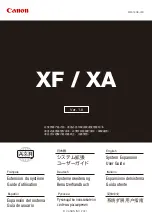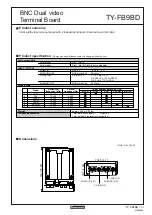
25
93-99
2-8
0-1
9-15
16-22
23-34
35-45
255
241-247
234-240
223-233
211-222
248-254
2
8
18%
Rec709
Green
Indigo
Teal
Light
Yellow Yellow
Light
Orange Orange
Red
M
ag
en
ta
B
la
ck
Skin
Original
luma
159-170
Turq
Blue
3
0
6
9
14
109
106
103
100
95
90
19
IRE
70
41
Dark
Blue
93-99
2-8
0-1
9-15
16-22
23-34
35-45
255
241-247
234-240
223-233
211-222
248-254
2
8
18%
Rec709
Green
Indigo
Teal
Light
Yellow Yellow
Light
Orange Orange
Red
M
ag
en
ta
M
ag
en
ta
B
la
ck
B
la
ck
Skin
Original
luma
159-170
Turq
Blue
3
0
6
9
14
109
106
103
100
95
90
19
IRE
70
41
Dark
Blue
6.8.1 Y Monitor Mode – Exposure Meter
In Monitor Y mode (Section 6.8) the Viewfinder operates as an
exposure meter, applying pseudo- (false) colour to indicate the
intensity of individual pixels in the image. The colours used,
and their relationship to Y’ (luma) video level (Figure 15) allow
the Viewfinder to provide simultaneous real-time exposure and
focus feedback to the camera operator.
Figure 15 Exposure Meter Colours
When Y Monitor is selected, colours shown in Figure 14 are
superimposed on the active video image to show intensity
within the image (Figure 16). The central 70 IRE range,
between 20 and 90 IRE, is shown in monochrome. As lighting,
aperture and shutter speed are adjusted, colours at the
extremes outside this central range change to indicate how
nearly these areas approach black- or white-saturation.
Nominal white, 100 IRE, corresponds to 700mV Ys video input
voltage. This voltage is digitised to 235 on the 2
8
greyscale of
256 levels displayed by the Viewfinder. In Y Monitor mode this
level appears yellow or light orange. Black and Magenta are
reserved for the hard cut-offs of 0 (dark) and 255 (light) on this
scale, respectively.
Two narrow bands are highlighted for specific exposure set-
up. A grass-green (Scottish green grass!) band centred on 41
IRE relates to 18% density, when using Rec. 709 Gamma. A












































